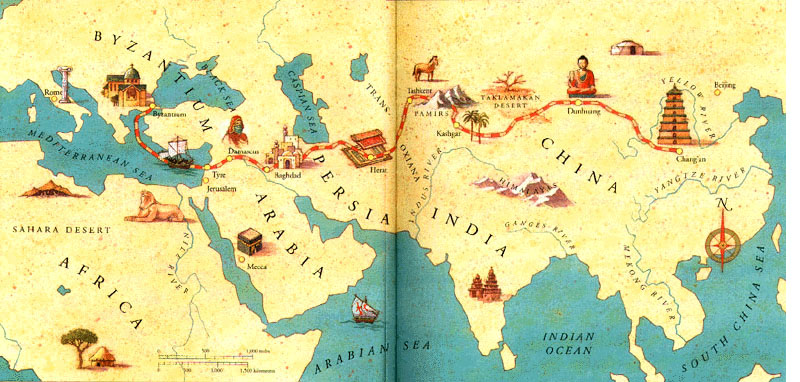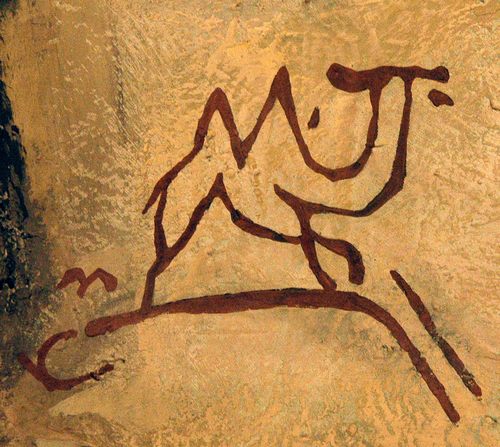Source: Click Here
Introduction
As discussed in other portions of this blog, one of the most developmentally essential roles camels have fulfilled to this day has been their presence on the Silk Road. The Silk Road became a prominent trading route while China was under the rule of the Han dynasty and Persia was being ruled by Parthians. The Silk Road really began to gain prominence as a trade route around approximately the first century AD, and this trade route was beginning to open trade between the East and West, which would be vital to both the economies of these areas. As this trade route developed, the Parthians began to use two-humped Bactrian camels to transport heavy loads of goods across the vast reaches of the road (Bulliet 164).

Source: Click Here
Camels Forging a Path
As shown by the map above, the journey from Persia to China included not only wide stretches of desert, but also a substantial amount of mountainous terrain. From nearly the emergence of this trade route, camels played an essential role in the transportation of goods (Bulliet 164). Not only were camels able to carry very great amounts of weight, but they could travel for extremely long distances without require rest or water. Camels had the perfect adaptations for harsh desert conditions in Central Asia and the Middle East, giving them the ability to carry heavy loads through these conditions surviving on desert plants and being able to carry on without water for up to two weeks (“Camel”). Studying artifacts paints a very clear picture of the extent to while camels were utilized on this route. Figurines have been discovered with Parthian remains at Seleucia and Uruk (modern day Iraq) that portray camels loaded with goods. Very similar loaded camel figurines were found in China that were clearly depicting the same two-humped camels, and that signified a connection between the two locations. The figurines were too identical to be considered a coincidence, and it’s clear that both civilizations valued the camel for its use in trade and economic expansion (Bulliet 164). Much evidence suggests that camels on the Silk Road traveled in far-stretching caravans, walking one behind the other, winding through the rugged terrains. These camel caravans, comprised of the two-humped camels, can be seen on drawings found at Dura-Europus, located on the Euphrates lands separating the Parthians and the Romans. The terrain of the Silk Road, as mentioned, was very diverse. Parts of the route in Arabia was known to be swampy, given its proximity to the ocean and river system cutting through the land. However, camels were even able to manage this landscape, utilizing their tall stature and powerful gait. Bulliet discusses evidence that three types of camels were bred for use along the Silk Road, particularity in the Arabian area. In the swamp lands between the Tigris and Euphrates, there were also pasture lands that provided a western terminal for the caravans traveling along the Silk Road from Central Asia. Breeds of camels included a one-humped, shaggy camel bred specifically for work on the Silk Road. There is also evidence of a two-humped shaggy camel, as well as a camel with one long hump contained a shallow dip in the center of the hump. These various breeds provide evidence of humans attempting to work with camels to develop the perfect pack animal for use on the Silk Road. With the camel’s high capacity for loads and ability to travel vast distances, civilizations looking to efficiently trade goods along the route had found the ideal pack animal. There are accounts that camels had the ability to carry 900 pounds of wheat (Bulliet 167-168). More realistic numbers of at least modern camels is a little more than 300 pounds for great distances, but they have been known to carry almost 700 pounds for short distances (Gauthier-Pilters and Dagg 109-110). The reason for the higher carrying capacity around the times of the Silk Road could be a result of a different breed of camel that existed at the time, but is not longer living, or it could be an exaggeration, but either way it speaks to these peoples’ opinion of the camel on it’s ability to be a useful animal along the Silk Road.

Source: Click Here
Development of Use
The breeding of camels for efficiency as a pack animal developing during the second century BC, just as movement along the Silk Road increased. Camels in Iran and Afghanistan were used a breeding stock, and by the time the Silk Road was used prominently by many civilizations several centuries later, hybrid camels had been created that were the perfect animals for movement of goods along the route. By this time, camels had become a “vital economic resource” (Bulliet 171). Camels had previously been used as a subsistence animal, but at this point, the trade along the Silk Road would not be possible without camels. Camels began to be bred in larger herds, and both nomadic tribes and civilized peoples were relying on the animal. Many societies, particularly in Central Asia, began to develop solely upon the camel, which included camel breeding, the trade of camel products such as milk, and the use of camels for both subsistence and trade (Bulliet 171). It’s difficult to say how these societies would have developed without the presence of the camel, but it’s clear that the economic development would have been less extensive without the ability for movement of goods across the vast stretches of the Silk Road. Camel caravans on the Silk Road, as mentioned, were long used by nomadic tribes. The caravans used by nomads could involve anywhere from several hundred to several thousand camels, and provided a means for safe traveling for the nomadic people. Nomads paid tariffs when traveling through the lands of other nomadic tribes, and in turn were offered safe travels through those lands (Gauthier-Pilters and Dagg 109-110). This exchange, revolving around the Silk Road, provided a path for development of the nomadic tribes. Therefore, the utilization of camels on the Silk Road aided the development of preexisting societies, as well as nomadic tribes in the early stages of development.

Source: Click Here
Conclusion
Camels have been described as “the bridge between Eastern and Western cultures” and was the beginning of major development for many civilizations, but none of this exchange would have been possible without camels. There was simply no other creature with its abilities for travel on the Silk Road (Potts). Despite the contributions of camels to human civilization, camels did not necessarily benefit from this exchange. Although it is difficult to find accounts of events on the Silk Road, caravans during the past several centuries have run into issues, and it likely that caravans on the Silk Road faced equally, if not more, hazardous conditions. Caravans often get lost, and one in 1805 lost their route from Timbuktu to Taoudeni, resulting in the death of 2,000 people and 1,800 camels from thirst and starvation (Gauthier-Pilters and Dagg 122). It is likely that a great many camels perished from heavy burdens and harsh conditions on the Silk Road, in addition to failed breeding experiments that were practiced in developing the perfect camel. Clearly, camels at this time were relentlessly exploited for economic development. Granted, many camel species were created and prolonged for use on the Silk Road, but was this existence the best for the camels? At what point in history will the human contribution to camels equal the contribution of camels to humanity?

Source: Click Here

13 Responses to Camels on the Silk Road